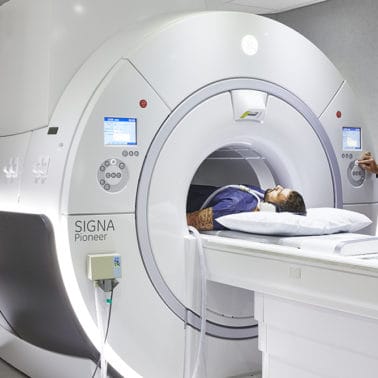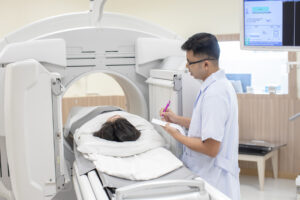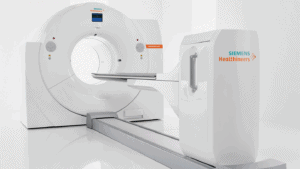
Crucial Role of Nuclear Medicine Technologists in Cancer Care
Did you know that we can use nuclear medicine to diagnose and treat cancer?
Nuclear medicine technologists play a crucial role in oncology. How? They use advanced imaging techniques to identify tumours, assess the spread of cancer, and monitor the effectiveness of treatments.
All of this is vital for early cancer detection and tailoring personalised treatment plans for patients, and so nuclear medicine has a significant positive impact on patient care and outcomes.
It’s an indispensable tool in the fight against cancer and other diseases — but how does it work? This article will walk you through everything you need to know about nuclear medicine and oncology.
The Role of Nuclear Medicine in Cancer Diagnosis
Nuclear medicine technologists are an important part of accurately diagnosing breast cancer, lung cancer, lymphoma, and other forms of cancer. They use sophisticated imaging technology to pinpoint disease in a patient’s body.
Accurate Diagnosis
Technologists administer radiopharmaceuticals, substances that emit radiation. They target and illuminate cancerous cells within the body. It’s like having a map that lights up areas of interest.
This precise approach gives doctors a detailed view of any tumours and metastases.
Role of Radiopharmaceuticals
When introduced to the body, these compounds accumulate in cancer cells due to their high metabolic rate.
Technologists then use gamma cameras to detect the emitted radiation, producing high-quality images that show the presence and extent of the cancer. This is why radiopharmaceuticals are crucial for identifying cancer, whether at the initial or the advanced stages.
PET Scans in Cancer Care: A Technologist’s Perspective

PET scans provide detailed images that are crucial for understanding the cancer’s behaviour and spread.
PET Scans in Oncology
Positron Emission Tomography (PET) scans use radioactive tracers to detect any active cancer cells, offering a dynamic picture of cellular function.
They’re invaluable for diagnosing, staging, and monitoring treatment response in cancer therapy and care.
Technologist’s Role
Nuclear medicine technologists are key in preparing and conducting PET scans. They make sure that the correct dosage of radiotracers is administered and provide instructions to patients for optimal imaging results.
During the scan, technologists operate the PET scanner, capturing the critical images that will guide the patient’s cancer treatment plan.
Administering Radiopharmaceuticals: Safety and Precision
Administering radiopharmaceuticals requires the utmost safety and precision to ensure the most effective cancer diagnosis and treatment. Here’s how nuclear medicine technologists meet these standards:
Safety Protocols
Technologists follow strict protocols to safely administer radiopharmaceuticals.
This includes verifying the patient’s information, confirming the correct drug and dose, and using protective equipment to minimise any exposure to radiation.
Precision in Dosing
The technologist calculates and delivers a precise dose of radiopharmaceuticals.
They consider factors such as the patient’s size and their specific diagnostic or therapeutic needs to ensure the best possible outcomes — all while prioritising patient safety and comfort to minimise side effects and anxiety.
Cancer Staging and Treatment Planning
Nuclear medicine plays a pivotal role in accurately staging cancer, helping to determine the extent of the disease and create effective treatment plans.
Accurate Cancer Staging
Through the use of advanced imaging techniques, nuclear medicine can identify how far cancer has spread within the patient’s body.
This is critical for accurately staging the cancer, influencing treatment decisions and assessments.
Technologist’s Role
Nuclear medicine technologists are instrumental in this process. They meticulously prepare and administer the radiopharmaceuticals needed for imaging in order to produce high-quality images.
Their expertise in operating imaging equipment and interpreting the images’ technical aspects helps doctors understand the cancer’s stage. Using this information, they can plan the most appropriate treatment plan that minimises discomfort and pain for the patient.
Collaboration and Communication in Oncology Teams
Effective cancer care heavily relies on collaboration. Every professional plays a vital role in shaping positive outcomes for cancer patients.
Interdisciplinary Collaboration
Successful cancer treatment depends on the collaboration between oncologists, surgeons, radiologists, nuclear medicine technologists, and other healthcare practitioners.
This team approach means that all aspects of diagnosis, treatment, and monitoring are cohesively managed for comprehensive patient care.
Communication Skills
Nuclear medicine technologists develop excellent communication skills. This is because they need to effectively communicate imaging results, explain procedures to patients and colleagues, and discuss the implications of their findings with other healthcare providers.
Their ability to communicate complex information in an easy-to-understand way is crucial for creating and implementing effective cancer treatment plans.
The Impact of Nuclear Medicine Technologists in Oncology

Nuclear medicine technologists are indispensable in oncology, especially when it comes to the future of radiotherapy and cancer care. They bring several vital skills to the table, enhancing every aspect of cancer care from diagnosis to treatment.
Vital Role in Cancer Therapies
These technologists deliver critical information that shapes cancer diagnosis, staging, and treatment.
By performing and interpreting complex imaging, they provide the data necessary for personalised and effective treatment plans.
Future Developments
The field of nuclear medicine is rapidly evolving, with new radiopharmaceuticals and imaging technologies on the horizon.
As these advancements unfold, the role of nuclear medicine technologists in oncology will expand, requiring continuous learning and adaptation. Their expertise will become even more important in developing innovative treatments and improving patient outcomes in the fight against cancer.
Enhancing Oncology Care with Nuclear Medicine
Nuclear medicine technologists are at the heart of oncology care, blending science with compassion to improve patient outcomes. Their expertise in handling radioisotopes and integrating advanced diagnostics influences treatment paths and patient experiences.
- Radioisotopes in Treatment: They skillfully use radioisotopes for targeted therapy, reducing risk and side effects compared to traditional chemotherapy. Remember that the procedure is already incredibly safe with little to no side effects.
- Content Development: Technologists contribute to patient education by developing clear, understandable reports with content on nuclear medicine applications.
- Risk Assessment: They use various tests and assessments to evaluate treatment risks and choose the most effective drugs for care.
- Research and Knowledge: In addition to their important work with patients, technologists stay at the forefront of oncology by participating in research, expanding their knowledge of new drugs and treatment types.
- Prevention and Early Detection: Through the early detection of cancers using specific radiopharmaceuticals, technologists play a key role in disease prevention and the assessment of effective treatment.
Nuclear medicine technologists not only enhance the accuracy of cancer care but also support the integration of innovative treatments. They’re an invaluable part of oncology and healthcare as a whole.
Innovation in Action: The Impact of Nuclear Medicine in Oncology
By recognising the critical work of nuclear medicine technologists, you can truly appreciate the full scope of the cancer care that they provide. Their behind-the-scenes efforts play such a pivotal role in diagnosing, treating, and monitoring cancers.
If you’re inspired by the impact of this profession, or you’re considering a career in nuclear medicine science and technology, we encourage you to explore the possibilities!
PRP Diagnostic Imaging offers a wealth of resources and opportunities for those interested in joining this dynamic field. For more information on careers and educational pathways in nuclear medicine technology, visit PRP Diagnostic Imaging’s Career Page on our website.
Join us in advancing cancer care through expertise, innovation, and compassionate service.
